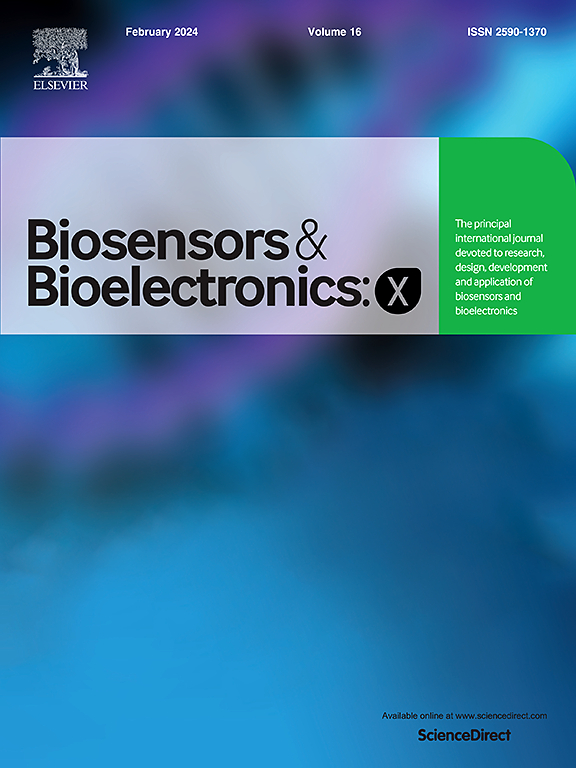Face-wearable integrated bioelectronics for quantitative, automated diagnosis of blepharospasm
IF 10.61
Q3 Biochemistry, Genetics and Molecular Biology
引用次数: 0
Abstract
Blepharospasm (BSP) is a neuro-ophthalmologic disorder marked by excessive blinking and involuntary contractions of the muscles around the eyes. Current standard clinical evaluations rely mainly on subjective assessments, often resulting in inconsistencies and human errors in diagnosis and severity monitoring. Here, we introduce a wireless, face-wearable, all-in-one bioelectronic system designed to continuously capture high-fidelity electrooculograms and electromyograms as a quantitative tool for diagnosing BSP. This device features soft membrane sensors and integrated circuits that ensure skin conformity, allowing for highly accurate signal detection on the face. The wearable system has been optimized in both design and functionality to detect a wide range of BSP-related issues across multiple patients, such as increased blink rates, eyelid fluttering, and prolonged eye closures. Our study shows that the normal blink frequency is similar (p = 0.546); however, the BSP group exhibits longer durations and higher amplitudes (p < 0.005). Partial blinks are more frequent and have higher amplitudes, but similar durations (p < 0.005). Long blinks are different in both frequency and duration, but not amplitude (p < 0.01). Flutter events also show group differences in frequency (p < 0.01) and duration (p < 0.005), with no amplitude difference (p = 0.168). A machine learning-based prediction model demonstrates an accuracy of 81.5 % and an F1-score of 0.814 when validated against expert-annotated video data. Overall, the combination of wireless soft bioelectronics and advanced machine learning algorithms, presented in this work, shows a first-of-a-kind approach to effectively and accurately diagnosing BSP.
用于定量、自动诊断眼睑痉挛的可穿戴式集成生物电子学
眼睑痉挛(BSP)是一种神经眼科疾病,其特征是过度眨眼和眼睛周围肌肉的不自主收缩。目前的标准临床评估主要依赖于主观评估,常常导致诊断和严重程度监测中的不一致和人为错误。在这里,我们介绍了一种无线的、可穿戴的、一体化的生物电子系统,该系统旨在连续捕获高保真的眼电图和肌电图,作为诊断BSP的定量工具。该设备具有软膜传感器和集成电路,确保皮肤一致性,允许对面部进行高精度信号检测。该可穿戴系统在设计和功能上都进行了优化,可以检测多个患者的各种bsp相关问题,例如眨眼频率增加、眼皮抖动和闭眼时间延长。我们的研究表明,正常眨眼频率相似(p = 0.546);然而,BSP组表现出更长的持续时间和更高的振幅(p < 0.005)。部分眨眼更频繁,幅度更大,但持续时间相似(p < 0.005)。长时间眨眼的频率和持续时间不同,但幅度没有差异(p < 0.01)。颤振事件在频率(p < 0.01)和持续时间(p < 0.005)上也存在组间差异,但振幅无差异(p = 0.168)。基于机器学习的预测模型在针对专家注释的视频数据进行验证时显示准确率为81.5%,f1分数为0.814。总的来说,无线软生物电子学和先进的机器学习算法的结合,在这项工作中,展示了一种有效和准确诊断BSP的第一种方法。
本文章由计算机程序翻译,如有差异,请以英文原文为准。
求助全文
约1分钟内获得全文
求助全文
来源期刊

Biosensors and Bioelectronics: X
Biochemistry, Genetics and Molecular Biology-Biophysics
CiteScore
4.60
自引率
0.00%
发文量
166
审稿时长
54 days
期刊介绍:
Biosensors and Bioelectronics: X, an open-access companion journal of Biosensors and Bioelectronics, boasts a 2020 Impact Factor of 10.61 (Journal Citation Reports, Clarivate Analytics 2021). Offering authors the opportunity to share their innovative work freely and globally, Biosensors and Bioelectronics: X aims to be a timely and permanent source of information. The journal publishes original research papers, review articles, communications, editorial highlights, perspectives, opinions, and commentaries at the intersection of technological advancements and high-impact applications. Manuscripts submitted to Biosensors and Bioelectronics: X are assessed based on originality and innovation in technology development or applications, aligning with the journal's goal to cater to a broad audience interested in this dynamic field.
 求助内容:
求助内容: 应助结果提醒方式:
应助结果提醒方式:


